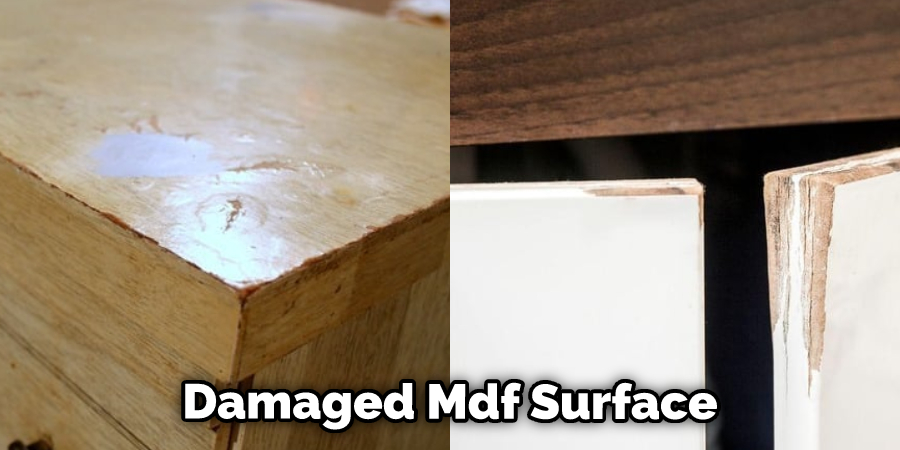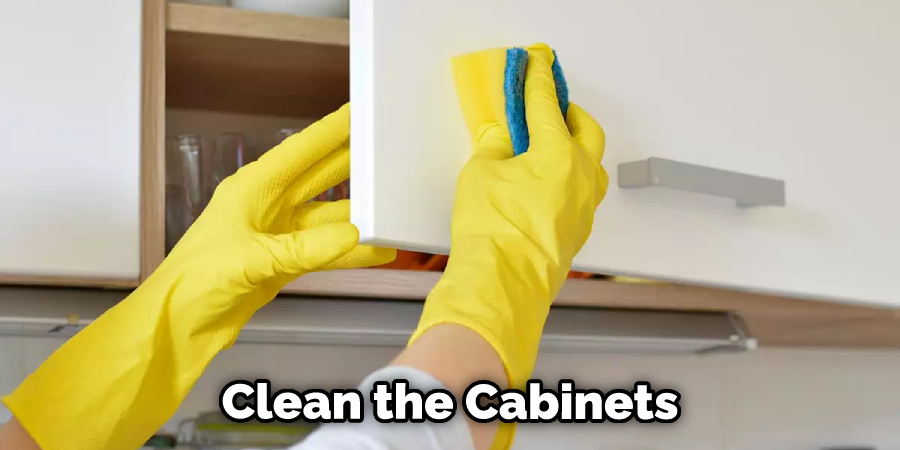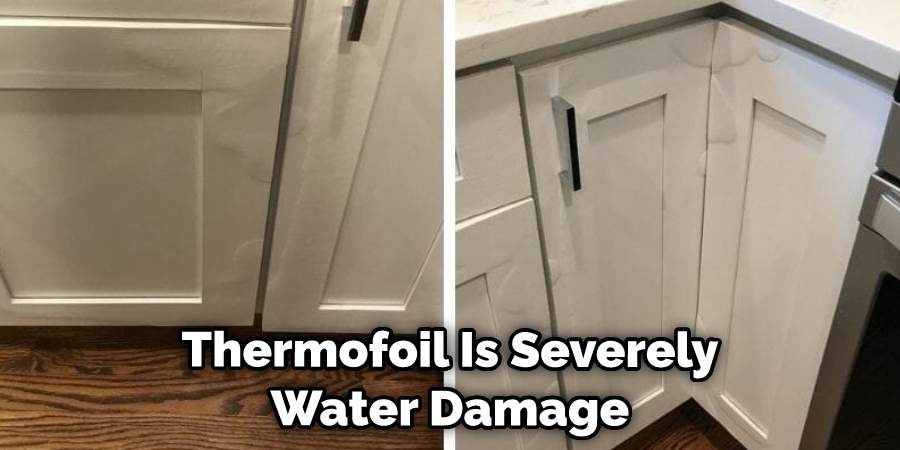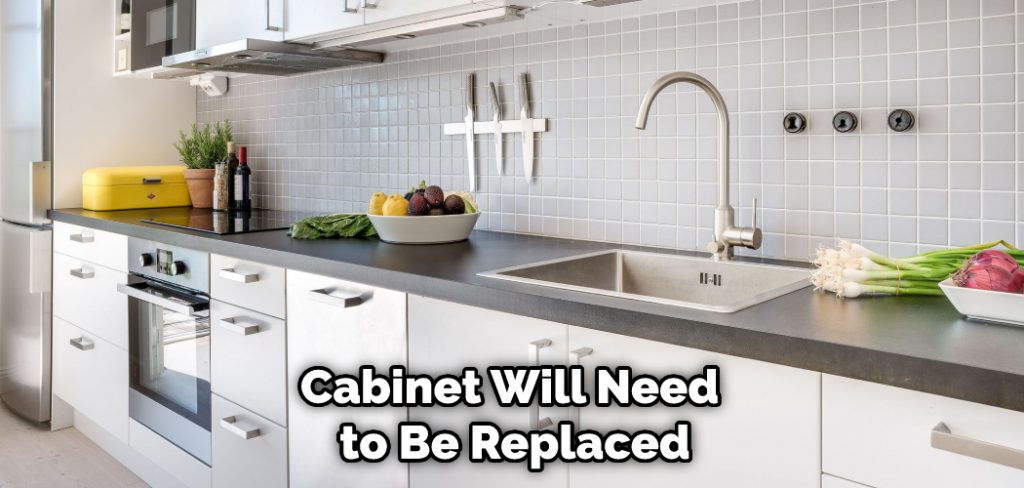Thermofoil cabinets are a popular choice for kitchen cabinetry because they are affordable and can be easily matched to other cabinets in the home. However, over time, thermofoil can start to peel, ruining your kitchen’s appearance. Fortunately, there are several ways to fix peeling thermofoil cabinets. Read on to find out how to fix peeling thermofoil cabinets.

Summary: Refresh your thermofoil cabinets with a simple DIY project. Remove the cabinet doors, apply primer, paint the cabinets, attach the doors back on, and reattach any hardware. Enjoy your new and improved cabinetry!
What Is a Thermofoil Cabinet?
A thermofoil cabinet is a type of kitchen cabinet that is made using a plastic laminate material. This material is glued to a plywood or particle board substrate using heat and pressure, creating a smooth, consistent finish. Thermofoil cabinets are usually less expensive than solid wood cabinets and are available in a wide range of colors and styles.
However, thermofoil cabinets are not as durable as solid wood cabinets, and the laminate surface can peel or bubble over time. Nevertheless, thermofoil cabinets are a good option for budget-conscious homeowners who want to update their kitchen without spending a lot of money.
Why It’s Important to Fix Peeling Thermofoil Cabinets?
Peeling thermofoil cabinets are not only unsightly, but they can also be a sign of bigger problems. Thermofoil is a type of laminate applied to cabinets using heat and pressure. Over time, the adhesive that bonds the thermofoil to the underlying substrate can break down, causing the material to peel away.
In addition to being an eyesore, peeling thermofoil can make cabinets more difficult to clean and lead to water damage. If you have peeling thermofoil cabinets, it’s important to have them repaired as soon as possible. A professional cabinet refinisher will be able to remove the damaged material and apply new thermofoil, restoring your cabinets to their original beauty.
How to Fix Peeling Thermofoil Cabinets
If you have thermofoil cabinets in your home and you have noticed that they are starting to peel, don’t worry; there is a way to fix them. In this guide, we will show you how to fix your thermofoil cabinets and have them look new again.
1. Remove the Cabinet Doors

The first thing you will need to do is remove the cabinet doors and any attached hardware. Once done, you will need to sand down the cabinets. Be sure to sand evenly so the new paint or finish will adhere properly.
2. Apply Primer
After sanding the cabinets, you need to apply a coat of primer. This will help the paint to adhere better to the thermofoil and will also help to prevent the peeling from happening again in the future.
You can use any primer you like, but we recommend using an oil-based primer for the best results. Apply the primer with a paintbrush or a roller, and make sure to cover all of the areas that you sanded.
3. Paint the Cabinets
Once the primer is dry, you can start painting the cabinets. Use a paintbrush or a roller to apply an even coat of paint. You may need to apply multiple coats of paint, depending on how dark you want the final color to be. Allow the paint to dry completely between each coat.
If you’re not happy with the final color, you can always paint over it again. Just be sure to follow the same sanding, priming, and painting process.
4. Attach the Cabinet Doors
Once the paint is dry, it’s time to attach the cabinet doors. Start by attaching the hinges to the door using a drill. Then, line up the door with the opening and use a screwdriver to secure it. Repeat this process for all of the doors.

5. Reattach Hardware
Once you have finished painting or staining the cabinets, you can reattach the hardware and doors. Be sure to screw the doors back on tightly, so they don’t come off easily.
6. Enjoy Your New Cabinets!
Now that you know how to fix peeling thermofoil cabinets, you can enjoy your new-looking cabinets. Be sure to follow the steps above carefully to get the best results. With a little effort, you can have cabinets that look like they did when they were first installed.
You Can Check It Out Fix a Cabinet Falling Off the Wall
How to Stop Peeling Thermofoil Cabinets
Peeling thermofoil cabinets are a common problem in many kitchens. The good news is that you can take a few simple steps to fix this issue. First, clean the affected area with a mild cleaner and a soft cloth. Next, apply a thin adhesive layer to the back of the thermofoil.
Finally, press the thermofoil firmly and allow it to dry for 24 hours. With these simple steps, you can easily repair peeling thermofoil cabinets and enjoy a kitchen that looks beautiful and functions properly.
What Causes thermofoil Cabinet to Peel?
There are several reasons why thermofoil cabinets might start to peel. One common cause is extreme changes in temperature or humidity. For example, if the cabinets are located near a heat source, they can expand and contract, which can cause the foil to separate from the MDF surface. Another possibility is that the MDF itself has been damaged.
Water can cause the MDF to swell and degrade, weakening the bond between the foil and the surface. In some cases, poor manufacturing can also lead to peeling issues. If the cabinets were not made correctly, then foil may not have adhered properly to the MDF, making it more likely to peel over time. Whatever the reason, peeling thermofoil cabinets can be unsightly and frustrating.

Fortunately, there are a few ways to fix the problem. One option is to replace the damaged panels with new ones. Another is to use a touch-up kit to cover up any peeling areas. With a little effort, you can make your cabinets look new again.
The Benefits of Fixing Your Peeling Thermofoil Cabinets
Peeling thermofoil cabinets are not only unsightly, but they can also be quite expensive to replace. If your cabinets are starting to peel, taking action immediately is important. Not only will this help prevent further damage, but it will also allow you to save money in the long run. In most cases, peeling is caused by moisture getting behind the thermofoil.
This can happen due to a leaky dishwasher or an improperly sealed cabinet door. Once the moisture gets in, it causes the adhesive to break down, resulting in the thermofoil lifting away from the surface. If you catch the problem early enough, you may be able to re-glue the thermofoil back into place.
However, if the damage is more extensive, you may need to replace the entire panel. Either way, it’s important to take action as soon as you notice any peeling, as this will help prevent further damage and keep your cabinets looking their best.
How to Prevent Your Thermofoil Cabinets from Peeling in The Future
You just had your kitchen remodeled, and it looks gorgeous. The new thermofoil cabinets are perfect with the granite countertops and stainless steel appliances. But a few months after the remodel is complete, you notice that the cabinets’ finish is peeling and bubbling in places. What went wrong?
Unfortunately, this is a common problem with thermofoil cabinets. The good news is that there are steps you can take to prevent your thermofoil cabinets from peeling in the future.
Here are a Few Tips:
- Make sure the surface of the cabinets is clean and free of grease before applying the thermofoil.
- Use a primer specifically designed for thermofoil applications.
- Make sure the room temperature is between 70 and 80 degrees Fahrenheit during application and curing.
- Apply several thin coats of thermofoil rather than one thick coat.
- Allow the thermofoil to cure completely before using the cabinets.
Following these simple tips, you can enjoy your beautiful kitchen for many years. Keep reading for more information about how to fix peeling thermofoil cabinets.

How to Identify if Your Cabinets Are Made with Thermofoil
If you’re considering new kitchen cabinets, you may have come across the term “thermofoil.” But what is thermofoil, and how can you tell if your cabinets are made with this material? Thermofoil is a type of plastic applied to a substrate, typically MDF or particleboard. The substrate is then heated, causing the thermofoil to melt and form a tight bond.
This bond creates a smooth, seamless finish resistant to peeling and chipping. Thermofoil cabinets are also easy to clean and maintain, making them a popular choice for busy families. If you’re not sure if your cabinets are made with thermofoil, look for a smooth, uninterrupted surface.
You should also be able to see the edge of the substrate material where it meets the wall or countertop. Ask your cabinet maker for more information if you can’t find these telltale signs. With a little investigation, you’ll be able to determine if thermofoil is the right choice for your kitchen.
What to Do if You Don’t Want to Fix Your Peeling Thermofoil Cabinets
If your kitchen cabinets are starting to show their age, you may be wondering if it’s time to replace them. However, if you don’t want to go through the hassle and expense of a full kitchen renovation, there are some things you can do to give your cabinets a refreshed look.
One option is to reface them with new doors and drawer fronts. This will give your kitchen a new look without requiring you to replace the entire cabinet. Another option is to paint your cabinets. Again, this can be a great way to give your kitchen an updated look without spending much money.
If you’re not ready for a full renovation, there are still plenty of options for giving your kitchen an updated look. Talk to a contractor or cabinetmaker about what would work best for your space and budget.
How Much Does It Cost to Fix Thermofoil Cabinets
Depending on the severity of the damage, it can cost anywhere from a few hundred to a couple of thousand dollars to fix thermofoil cabinets. The repair cost will depend on the size of the cabinet, the type of damage, and the extent of the damage. For example, if there is just a small crack in the thermofoil, it will only cost a few hundred dollars to fix.

However, if the thermofoil is severely damaged or there is water damage, it could cost a couple of thousand dollars to fix. Overall, the cost of fixing thermofoil cabinets will depend on the severity of the damage.
Are Thermofoil Cabinets a Good Choice for Cabinets?
When it comes to kitchen cabinets, there are many different materials to choose from. Wood, laminate, and thermofoil are popular options, but which is right for your kitchen? Thermofoil cabinets are often a good choice for kitchens because they are affordable and easy to care for.
Thermofoil is a type of plastic applied to a substrate, such as MDF or plywood. The thermofoil is then heated and pressed onto the substrate, creating a smooth, seamless surface. Thermofoil cabinets are very durable and resist staining and chipping. They are also easy to clean; wipe them down with a damp cloth.
However, heat can damage thermofoil cabinets, so it is important to avoid placing hot pans directly on the surface. Nevertheless, if you’re looking for an affordable and easy-to-care-for option for your kitchen cabinets, thermofoil may be the right choice.
Frequently Asked Question
Can You Fix Peeling Thermofoil?
The answer to this question is yes; you can fix peeling thermofoil. However, it can be a little bit tricky. In order to do so, you will need to remove the peeling layer of thermofoil and then reapply it to the cabinet.
Can Thermofoil Cabinets Be Refaced?
Thermofoil cabinets can be refaced if the peeling is only on the surface. However, if the peeling is affecting the core of the thermofoil, then the cabinet will need to be replaced.

Conclusion
While this may seem like a daunting task, it is doable. With the right supplies and some elbow grease, you can have your cabinets looking good as new in no time! Thanks for reading our post about how to fix peeling thermofoil cabinets. Have you tried repairing thermofoil cabinets before? What tips would you add?
You May Also Read: How to Fix Scratches on Kitchen Cabinets
